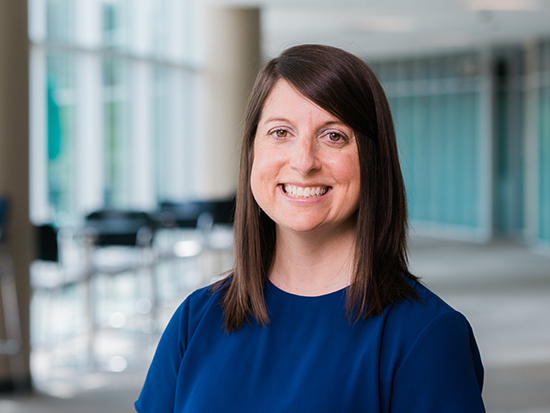 Rebecca Rampe, Psy.D., assistant professor in the Department of Psychiatry and Behavioral Neurobiology and director of the department's Developmental Trauma and Traumatic Grief Clinic, teaches a two-semester standalone course in the Neurosequential Model of TherapeuticsTM, starting this fall. It is open to all graduate students.UAB graduate students interested in learning more about the Neurosequential Model of TherapeuticsTM can now enroll in a two-semester standalone course starting this fall. NMT, developed by Bruce Perry, M.D., Ph.D., of Northwestern University, integrates core principles of neurodevelopment and traumatology to inform work with children, families and the communities in which they live, according to its website. It is not a therapy itself, but a clinical decision-making tool, says course instructor Rebecca Rampe, Psy.D., assistant professor in the Department of Psychiatry and Behavioral Neurobiology and director of the department’s Developmental Trauma and Traumatic Grief Clinic.
Rebecca Rampe, Psy.D., assistant professor in the Department of Psychiatry and Behavioral Neurobiology and director of the department's Developmental Trauma and Traumatic Grief Clinic, teaches a two-semester standalone course in the Neurosequential Model of TherapeuticsTM, starting this fall. It is open to all graduate students.UAB graduate students interested in learning more about the Neurosequential Model of TherapeuticsTM can now enroll in a two-semester standalone course starting this fall. NMT, developed by Bruce Perry, M.D., Ph.D., of Northwestern University, integrates core principles of neurodevelopment and traumatology to inform work with children, families and the communities in which they live, according to its website. It is not a therapy itself, but a clinical decision-making tool, says course instructor Rebecca Rampe, Psy.D., assistant professor in the Department of Psychiatry and Behavioral Neurobiology and director of the department’s Developmental Trauma and Traumatic Grief Clinic.
The NMT assessment process includes considering the nature and timing of a person’s childhood adversity, including abuse, neglect and exposure to violence; past and present relational and environmental supports; and current neurodevelopmental functioning.
“NMT is very creative and holistic in how it looks at therapeutic approaches,” Rampe said. “It gives you a lens for how you view somebody you are working with — including their adversity history, their relational health and their nervous system functioning. It is painting a picture versus labeling someone with a diagnosis.”
When Rampe sees a patient with sensory processing concerns, for example, she may refer them to an occupational therapist as well. Developmental trauma can cause such significant dysregulation that it is difficult to tease apart a sensory concern versus past early life associations. “They may be sensitive to sound because they have a lot of history connected with loud sounds; someone hurt them or was banging things, making these sounds very threatening. OT is an ideal additional intervention,” Rampe said. “Having this training makes you more aware of how developmental trauma continues to affect the lives of people you work with as a therapist, educator, social worker or other professional.”
The course, offered in the School of Health Professions, is open to all UAB graduate students. “This is the only course of its kind in the country that is open to graduate students from multidisciplinary backgrounds,” Rampe said. Through the course, students complete Phase 1 certification through the Neurosequential Network, with certification fees included in their tuition, Rampe says. Rampe is a Neurosequential Model of Therapeutics Phase 2 trainer. She began teaching the course one year ago as part of the Multitiered Approach to Trauma Certification program in the Department of Occupational Therapy, which prepares graduates to implement trauma-informed practices and policies in their professional practice.
Starting in fall 2025, the course is open to any graduate student with approval to include it as an elective. It will be taught in fall and spring as OTC 620 - Neurosequential Model Phase 1: A and OTC 625 - Neurosequential Model Phase 1: B. The Phase 1 certification along with course credit is a major benefit for students, Rampe added: “You gain access to this professional network with certification that is incredibly valuable.” These courses were supported by Rachel Ashcraft, program director of the Multitiered Approach to Trauma Graduate Certificate. The Phase 1 courses may also count toward the 15 credit hours required for the certificate, which is also open to all UAB graduate students.